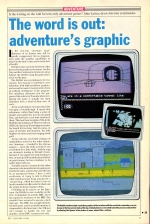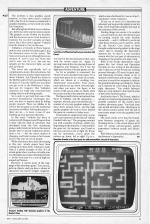
Personal Computer News
 14th January 1984
14th January 1984
Author: John Lettice
Published in Personal Computer News #044
The Word Is Out - The Adventure's Graphic
Is the writing on the wall for text-only adventure games? John Lettice draws his own conclusions
Is the text-only adventure dead? Rumours of its demise may still be greatly exaggerated, but as programmers push the graphics capabilities of micros to the limit, it may not be in the best of health.
The Spectrum was in the forefront of the drive towards graphics adventures, but the Oric and the Commodore 64 are now close behind, The Hobbit being the game that's so far set the pace.
The Hobbit was revolutionary for two reasons: first because it combined a text adventure with high-resolution graphics, and second because it incorporated a form of artificial intelligence in the program. The subsidiary characters (for the purposes of this article we'll assume whoever is playing the game is actually the main character) have a mind of their own, of sorts.
As far as adventures are concerned, this was quite a breakthrough. It meant that adventures, rather than being a series of puzzles you could solve in your own good time, can now have a real time element in them. The most basic example of this in The Hobbit is the tendency of Thorin to tell you (Bilbo) to "hurry up" if you happen to pause for breath for too long. And of course, in cases of extreme prevarication, the little blighter sits down and starts singing about gold...
Along with this you'll find evidence of independent action by the other characters. Someone - Gandalf is the obvious suspect - turns the trolls to stone if you avoid them for a little while. And the cogs are obviously turning in Elrond's brain, because if you spend too long chatting to him, or turn up in Rivendell repeatedly for no good reason, he has a tendency to be rather short with you.
Variable courses of action for the other characters also mean that no two games are exactly the same, and in some cases this can be an unexpected bonus. I have a vivid recollection of trying to talk to Elrond while simultaneously being attacked by a "vicious warg", which had taken it into its head to wander into Rivendell to check out the action. It doesn't happen often...
Following up its success on the Spectrum, The Hobbit is now available on the Oric, Commodore 64 and the BBC, but it has exposed a weakness of the BBC that wouldn't have occurred to anyone a short time ago. The BBC has enough memory for most tasks, and its available memory if comparable to the Spectrum's - but 32K just isn't enough to handle the text and graphics - so the BBC version is text only.
The problem is that graphics guzzle memory, so they either need a machine with a fair bit of memory committed to graphics handling, or they need one with a lot of memory.
But although The Hobbit was revolutionary, there was still room for improvement. The graphics on The Hobbit are detailed, and the characters move from location to location, but you don't actually see them move. By a short nose Legend's Valhalla beat The Oracle's Cave on this one.
Valhalla is set loosely in Norse legend, and its most notable breakthrough is that the characters move on the screen. The basic screens are good, although there is an element of "you've seen one Norse hall you've seen 'em all" to it, but you can actually see the characters fight, eat and pick up objects.
The social side superficially isn't as complicated as many other adventures, but this does illustrate another important point about Valhalla. Ask Elrond for advice in The Hobbit and he'll tell you something on the lines of "Take the Old Forest road until you get as far as the Bricklayer's Arms, then ask for Aragorn." But Valhalla's characters are really only concerned with trading objects and hitting people.
So in order to get help from one of the assorted Scandinavian personages present, you have to impress them by hitting people yourself. There are riddles to be solved, but the game is not the traditional succession of riddles. Solving the quests - there are six - is more a case of your building up your personal charisma.
In this sense, Valhalla has more in common with Dungeons and Dragons than it does with the kind of adventure that developed from the first mainframe games, and it tends not to be to the taste of people who've played traditional adventures a lot - but the micro market is changing, and from its sales so far it seems to be to the taste of a lot of people.
While adventures have been developing in this way, arcade games have been coming up to meet them. Ultimate's Atic Atac is a prime example of this. It's an arcade game where you have to battle your way through a succession of haunted rooms - at the very least it's a sort of high-res souped-up Pacman.
However, it carries many of the trappings of the adventure game. You can eat, pick up objects, and you have a choice of characters you can be: knight, magician, serf (surf in the documentation that came with the review copy!) etc. Again it's moving towards the role-playing format of Dungeons and Dragons, but it has the high-speed action of arcade games as well.
As far as graphics is concerned, The Oracle's Cave is another front runner. It's a maze-style game set in a series of caverns, which are shown in a scrolling two-dimensional cross-section. Your movement options are up, down, left and right, and when you move, the figure in the centre of the screen walks or climbs while the screen scrolls in the opposite direction.
The figure itself is better articulated than those in Valhalla, and the oppositing - serpents, wizards, giant rats and the like - consists of very nice graphics indeed. But these don't actually move, and the high quality graphics do seem to have limited the game in a number of other ways.
Commands are single letter only, so you can't enter sentences on the lines of ATTACK GANDALF WITH AXE. The program presents you with a number of options, which vary depending on the situation. Confronted by the giant rat, for instance, you'll tend to find you can move (m) or fight (f). If you opt for movement, you're given the options up, down, left or right. Up is u which is also shorthand for 'use an object', and leads to some confusion.
If you try to move in a direction not allowed, you're given the option to ask for help, but I found this dumped me back at the entrance of the caverns.
Finding things also seems to be random - you can build up a fair old collection just by looking around the same location repeatedly - and it's difficult to work out what these artefacts can be used for. All in all, The Oracle's Cave seems to have brought sophisticated graphics to the stage where they're draining the Spectrum's memory drug. So there's a very practical reason why the text part of adventures is changing as the graphics are improving.
Back in the arcade department, maze games like Ant Attack and Operation Gremlin are also erring on the adventure side. In the case of Ant Attack you're being pursued through a 3D maze by giant ants, and Operation Gremlin claims to be "a mixture of adventure and intrigue", where you have to search for weapons to destroy the gremlins infesting a scrolling city. Extra zip is injected by your being not one but eight characters. You switch between these in a style similar to that used in some of the better football games.
And finally there's The Forest, which is actually an orienteering simulation, but is a possible candidate for the world's most realistic adventure game. You hack your way uphill and down dale, checking in at the various control points with the aid of your trusty maps (very nice graphics) and compass.
The point seems to be that the boundaries between categories of games are breaking down, to the extent where we'll soon be seeing cartoon-quality games somewhere between arcade and adventure.
Walt Disney could certainly cash in with the Sorceror's Apprentice...
This article was converted to a web page from the following pages of Personal Computer News #044.



